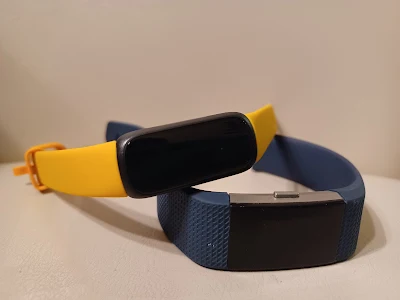There's no need to buy new technology just for the sake of having new technology, in my opinion. I will use things until they wear out to the ground. I held onto my LG phone a year after they stopped manufacturing phones entirely.
I still use a laptop from 2019 that I got refurbished from Best Buy despite it literally having pieces falling off of it. And I do have other computers that I use (Thank you, you know who you are) but technically, that laptop still works so why not use it for personal stuff?
This (Yellow one) is the Fitbit Inspire 3. I have the Fitbit Versa 2 (Blue one) from 2018 or so, which means it was probably made in 2017 and just sat on the shelf. I was a bit due for a wearable technology upgrade.
It took a lot of thought to spend the 99$ to buy this watch, when my old one was, while failing, still doing the basics. I don't like to throw things out if they can still be used.
Maybe I'll put it on my dog.
This recent FitBit was manufactured in I believe late 2022, around September If the spec sheet on Target's website is correct.
This FitBit Inspire 3 is a lot slimmer and there's a host of new features. It took me 3 days of using this to realize a big difference - The screen is in color! Greens, blues, reds! The Versa was only a digital white on black.
Physically, it seems a bit more robust -- It's taken several bumps to no ill effects or scratches.
A feature I won't use is the find my phone feature -- I do not want Google, who owns FitBit, to have any more of my information or location information than totally necessary.
CONS: if this Inspire 3 wasn't screaming at me to download the app to set it up, I wouldn't have. There's not a lot of need for it unless you'd like to change some of the settings for exercise tracking.
I just would have liked the count steps. I turn off location tracking and remove the permissions from the FitBit app until I absolutely need to use it. My old watch would lose time slowly over the course of the years -- It's still about 8 minutes behind the true time, whereas this one is maybe 10 seconds or so.
Turns out it was losing time because I hadn't connected it to the app in years, although I remember doing so some years prior and the time still did not sync properly. Ah well.
PROS: Turning off the screen via a setting so that it doesn't automatically wake upon me turning my hand. That was one thing that prevented me from sleeping with my old Versa on my arm. Also sometimes you just have to let your technology rest.
MIDDLE OF THE ROADS: The Fitbit Inspire 3 does brag about a max 10-day battery life and so far I'm not super sure about that. I charged it when I got it out of the box initially and after set up it was from about 100% to about 98% I believe. And now, the next morning, it's at 93%.
I'm not looking at it all the time, I actually turned off the screen while I slept, so I'm not sure where the battery is going so far - It loses more power being off of my wrist than being on it. IS it searching for me?
Either way, it's still better than the failing battery of my Versa 2.
ADDENDUM, 4/16: After about 3 weeks of use, the battery life is still the most annoying thing about it. It chips away as it, presumably, searches for the connectivity to my phone, something I do not want to give it.
I wore it while I went for a walk and used my Galaxy Buds -- Because Bluetooth was turned on on my phone, a text also buzzed my wrist. The ecosystem may work for other people, but I prefer my devices single-use.
PROS: I like being able to flick through and see the various variations on how the steps I take translate. For instance, there is one that says that this amount of steps I've taken translates into three flights of stairs.
There is also an Sp02 Count. Sp02 is the amount of oxygen in your blood. I do remember telling it to track irregular heartbeats, the data of which it is no doubt using to build a file on me that Google will sell to advertisers. Whomp Whomp! At least Bing gives me giftcards for my search information!
I turned on the walk activity tracker at the gym and it seemed hellbent on
using location services to attach to the app and track me.
I did not let it.
It showed information such as pace and minutes walked.
OVERALL: It's a lighter version of the 2018 watch, with a color screen, more tracking metrics, and as of March 28th 2023,
no social component to gamify exercise anymore.
Still fun!


Comments
Post a Comment